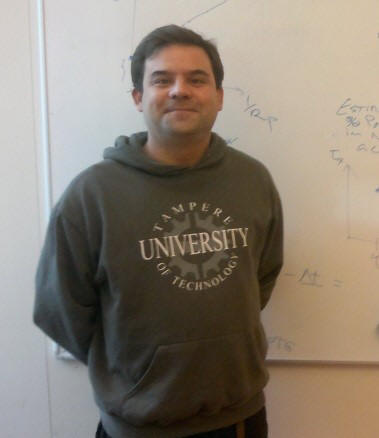Invited Talks
Day 1 – 15th May 2014 |
|
 |
Olli Yli-Harja |
| Title: | Big data, machine learning, and cancer |
| Abstract: | As biology is becoming an information science, Big data holds a promise of revealing secrets of complex diseases. But computers just compute and machine learning is just a tool. In order to utilize it, an intelligent user is needed to define suitable data structures that match purpose and context. We apply machine learning in the context of prediction of tumour phenotype. Such prediction from genomic data is notoriously difficult. Therefore we utilize the known association of genes with pathways, adding the layer of pathways to the internal representation of a machine learning system. Association of genomic data to pathways facilitates prediction of tumour phenotype. We conclude that integration of relevant background knowledge can lead to feasible solutions of complex problems in Big data. |
| Biography: |
During the years 1988-1992 Olli Yli-Harja was a research scientist at the Technical Research Centre of Finland, in 1993-1996 he was a lecturer in computer science in Helsinki University of Technology, and in 1997-1998 an Assistant Professor in University of Helsinki. In 1998 he was a research fellow at East Anglia University, Norwich, UK. In 1998-2001 he was a Senior researcher at the Institute of Signal Processing in Tampere University of Technology. In 2005, he was a visiting scientist in the University of Texas M. D. Anderson Cancer Center, Houston. Currently he is a Professor in the Department of Signal Processing in Tampere University of Technology, Finland and leads the Computational Systems Biology research group. He is also Affiliate Faculty member at Institute for Systems Biology, Seattle, WA. |
|
|
|
 |
Antti Ylipää |
| Title: | Identifying previously unannotated cancer specific transcripts using RNA-sequencing |
| Abstract: | Cancer is a leading cause of death worldwide accounting for 13% of all deaths in 2008, and the percentage is projected to continue rising. Cancer is a generic term for a group of genetic diseases that arise due to accumulation of advantageous mutations to a cell.s DNA. Genomic alterations bring about changes in the way the genome is transcribed which enable the cancer cells to proliferate uncontrollably. Although different tumors often share a number of mutations, their genomes and transcriptomes are essentially unique in many respects which makes it difficult to treat them effectively. Recently, genome-wide RNA-sequencing studies have identified several hundreds of previously unannotated long non-coding RNA molecules (lncRNAs) that may only be expressed in certain subtypes of cancers. Despite lacking protein coding potential, some of these rare transcripts have been shown to play a key role in oncogenesis. For example, Prostate Cancer Associated Transcript 1 (PCAT1) has been shown to regulate an important tumor suppressor gene BRCA2, and to control homologous recombination in prostate cancer. We have performed RNA-sequencing experiments from 41 prostate tumors to screen for novel lncRNAs. By conducting transcriptome assembly, we identified 145 previously unannotated intergenic prostate cancer associated transcripts or isoforms, including an ERG regulated transcript PCAT5 whose knockdown resulted in a dramatic effect on cell growth, migration, invasion and apoptosis specifically in PCAT5-positive prostate cancer cell lines. Genome-wide expression analysis indicated that PCAT5 works as a regulator of proliferation pathways. We have also developed alternative approaches to computationally intensive transcriptome assembly for discovering novel loci of expression from very large sample cohorts, such as those provided by the Cancer Genome Atlas (TCGA) consortium. Application of these methods to TCGAs RNA-sequencing data has resulted in identification of novel transcripts in a brain cancer that have subsequently been experimentally validated. |
| Biography: | Antti Ylipää graduated from Tampere University of Technology with a Master of Science degree in Biotechnology in 2008. He has been studying computational systems biology and bioinformatics approaches to understanding genomics from high-throughput data for 8 years. He is now finishing up his Doctoral Thesis on computational cancer genomics in University of Tampere under Professor Matti Nykter.s supervision with whom he has contributed to over 15 peer-reviewed publications. During his graduate studies in 2011 he founded a bioinformatics and biological data analysis company Genevia Technologies which he now leads as its CEO. |
|
|
|
 |
Meenakshisundaram Kandhavelu |
| Title: | Advances in understanding noisy signal transmission in neuronal cancer cells - GPR17 as a case study |
| Abstract: | Study of signaling networks in neuronal cells provide the unique opportunity to uncover the basis of many diseases. It helps in the development of novel therapeutic strategies to treat neurological disorders, neuronal tumors and cancers. Many of the genetic and epigenetic aberrations leads to cancer states are due to inappropriate activation/inactivation of intracellular signaling pathways. Such signaling cascades usually proceed from the cell surface, where extra cellular factors interact with their specific receptors i.e G-Protein Coupled Receptors (GPRs). A report shows (Lecca et al. 2008) the activation or suppression of GPR17 in diseased neuronal cells has potential impact in altering the tumor conditions. Many neuronal cancer (Lecca et al. 2008; Boda et al. 2011) cells showed differing expression levels of GPR17. The role of GPR17 receptor and their interaction with various signaling pathways and its importance in neuronal signal transduction are currently not well understood. Recent developments in sequencing methods provide informations on wide varieties of mutated states of GPR17, which makes it a difficult pharmacological target. A report shows critical mutation in this receptor evidently affects the binding of known ligands (Parravicini et al. 2010). From the caner sequencing and 1000 genome projects many forms of mutations reported. Implications of these mutations in signal fidelity, transduction accuracy and consequences in pathways yet to be studied. Present study focus on such novel signals in the complex network of pathways in neuronal cancer cells. About 500 unique cases of GPR17 with mutations from 4 different types of neuronal cancers were analyzed with major focus on Glioma. From our study we found that many of the mutated GPR17 are not able recognize and bind with previously reported ligands or binds with different orientation and interaction energy. It implies the necessity of more specified and customized designing of ligand molecules with the consideration of mutations present, towards the development of personalized medicine. |
| Biography: | Meenakshisundaram Kandhavelu graduated in Zoology (Spl. Biotechnology) from The American College, Madurai Kamaraj University, India in 2002. Followed by Masters graduation in Animal Biotechnology, Bharathidasan University, India in 2005 and he did mobility research in stem cell and developmental biology research group, Genomic Institute of Singapore, Singapore in 2004-2005. After that, in 2008 he finished PhD in Pharmaceutical Sciences (research disciplinary Chemical and Pharmaceutical sciences and biotechnology) from the University of Camerino, Italy, supervised by Prof. Gabriella Marrucci and Prof. Maria P. Abbracchio (mobility research work, University of Milan). During 2009 he worked as a Post-doctoral researcher with Prof. Michael J. Courtney, A.I.Virtanean Institute for Molecular Sciences, Finland. Later, since 2010-2012 he continued his post-doctoral research work with Assistant. Prof. Andre S Ribeiro and Prof. Olli Yli-Harja at TUT. Since June 2013, he is the Principle Investigator of MS Lab (Molecular Signaling Lab) in the same department.
Currently MS Lab (link) focuses on understanding intracellular molecular signaling networks. These networks play a crucial role in cell fate determination. Improper intra and/or extracellular signal transduction affects cells well-being and lead to various diseases. We investigate molecular signaling networks at the single cell level, to identify canonical and non-canonical pathways involved in cell signaling and cell fate. We are specifically interested in understanding the role of extracellular signal transmissions in cells, and how it interacts with the internal signaling networks and transcriptional regulators. |
|
|
|
 |
Sara Madeira |
| Title: | The NEUROCLINOMICS project: Understanding NEUROdegenerative Diseases through CLINical and OMICS Data Integration |
| Abstract: | The need for integrative approaches to provide a broader understanding of brain related pathologies, in general, and neurogenerative diseases, in particular, has been largely recognised. These approaches should infer relationships between omics, clinical, and personal data. In NEUROCLINOMICS, we are interested in the development of innovative approaches to understanding neurodegenerative diseases through heterogeneous data integration. We work on the development of a sophisticated knowledge discovery system to integrate powerful data mining algorithms to unravel potentially relevant links between omics and clinical data. Disease diagnostic and prognostic markers, disease progression rates, and patient profiles, are tackled. Together with the challenging task of studying complex diseases we also embrace the challenging topic of developing efficient and effective mining algorithms for biomedical data integration. We now use Amyotrophic Lateral Sclerosis and Alzheimer's disease as case studies. |
| Biography: | Sara C. Madeira received a (5-year) BSc degree in Computer Science from the University of Beira Interior, Covilhã, Portugal, in 2000, and the MSc and PhD degree in Computer Science and Engineering (CSE) at Instituto Superior Técnico (IST), Technical University of Lisbon, in 2002 and 2008. She is currently an Assistant Professor, at the CSE department at IST, where she teaches undergraduate courses on algorithm and data structures and graduate courses on computational biology and data integration for bioinformatics. She is also a senior researcher at the Knowledge Discovery and Bioinformatics (KDBIO) group at INESC-ID, Lisbon. Her research interests include algorithms and data structures, data mining, machine learning, bioinformatics and medical informatics. In this context, she is currently the principal investigator of the NEUROCLINOMICS (Understanding NEUROdegenerative diseases throught CLINical and OMICS data) project. NEUROCLINOMICS aims at the development of innovative approaches to understanding neurodegenerative diseases through heterogeneous data integration. It also aims at the development of sophisticated knowledge discovery system to integrate powerful data mining algorithms to unravel potentially relevant links between omics and clinical data, tackling disease diagnostic and prognostic markers, disease progression rates, and patient profiles. In this context, together with the challenging task of studying complex diseases it embraces the challenging topic of developing efficient and effective mining algorithms for biomedical data integration, using Amyotrophic Lateral Sclerosis and Alzheimer's disease as case studies. |
|
|
|
 |
Samuli Niiranen |
| Title: | Convergence in clinical diagnostics |
| Abstract: | There is an increasing functional convergence both within the traditional specialties of the clinical laboratory (clinical chemistry and hematology, anatomic pathology, clinical microbiology and clinical genetics) and also between clinical imaging diagnostics and laboratory diagnostics. This convergence is due to a number of new and emerging technological and operational innovations including, but not limited to, molecular diagnostics, digital pathology and the LEAN production system. These innovations and their implications for informatics solutions in clinical diagnostics are discussed. |
| Biography: | Samuli Niiranen, D.Sc., is Vice President of Engineering at Mylab Oy leading the software development activities at the company. Mylab Oy is the leading Finnish provider of laboratory information services and systems for clinical laboratories. Dr. Niiranen is the author or co-author of more than 30 scientific publications and text books in biomedical informatics, multimedia and other fields. He received his M.Sc. (Tech.) and D.Sc. (Tech.) degrees from the Tampere University of Technology in 2001 and 2005, respectively. He was a post-doctoral research fellow at the Decision Systems Group of Brigham and Women's Hospital and Harvard Medical School from 2006 to 2007. He is currently studying for an MBA at Aalto University Executive Education. He has received a number of awards and commendations, including the Nokia Corporation Educational Award in 2003. Dr. Niiranen was a member of a consortium selected as a finalist for the eEurope Awards for eHealth 2003 organized by the European Commission. Dr. Niiranen was born in 1977. |
|
|
|
 |
Isabel Gordo |
| Title: | Adaptation of bacterial populations approaching a fitness peak |
| Abstract: | Populations adapt to novel environments through the successive accumulation of adaptive substitutions. This adaptive process is dynamic and expected to depend both on the fitness landscape characteristic of a given environment and on the genetic background on which new mutations arise. One of the oldest models of adaptive evolution was proposed by R.A. Fisher and its known as Fisher's geometrical model (FGM). FGM assumes that organisms climb a fitness landscape characterized by a single peak by performing an adaptive walk towards that phenotypic peak. Here we model bacterial adaptation under a range of parameter values which have reasonable biological support. We find that FGM extended to allow for small random environmental variations is able to explain several observations made recently in experimentally evolved populations. Consistent with data on populations evolving under laboratory controlled conditions, the model predicts that: mean population fitness increases rapidly when populations face novel environments and then achieves a dynamic plateau; the rate of molecular evolution is remarkably constant over long periods of evolutionary time; bacteria with a mutator phenotype are expected to frequently invade such evolving populations; and patterns of epistasis vary along the adaptive walk. Negative epistasis is expected in the initial steps of adaptation, as observed in currently available data, but not at later steps, a prediction that remains to be tested. Furthermore, populations are expected to exhibit high levels of phenotypic diversity at all times during their evolution. This implies that populations are possibly able to adapt rapidly to novel abiotic environments. |
| Biography: | Isabel Gordo has a PhD in Evolutionary Genetics from the University of Edinburgh, Scotland, where she studied theoretical models of evolution of clonal populations. She is currently a PI at the Institute Gulbenkian de Ciencia, Portugal, where she leads a research group in Evolutionary Biology. The group aims at understanding the adaptive process of bacterial populations evolving in simple and in complex ecosystems. One of the specific aims is estimating key evolutionary parameters, namely the rate and fitness effects of mutations across environments and genetic backgrounds; another aim is dissecting the genetic basis of adaptation. For that the group uses Escherichia coli as a model organism and experimental evolution as a method. In addition it also develops theoretical and simulation models, which aim at a quantitative understanding of the evolutionary process occurring in experimentally evolved populations. Main questions of current interest are: understanding the regime of adaptation that occurs when E. coli evolves as a commensal bacteria in the mouse gut; determining the genetic bases of pathoadaptive mutations that are responsible for increasing the virulence of E. coli; studying the nature and strength of epistasis in the evolution of antibiotic resistance. |
|
|
|
Day 2 – 16th May 2014 |
|
 |
Reija Autio |
| Title: |
Recycling high-throughput data: combining existing data can lead to new knowledge |
| Abstract: | High-throughput studies providing large amounts of data are in routine use in biomedical research. In addition to the importance of the original findings, this data may have value in wider context when combined with other previously acquired and published results. These published genome-wide data can be exploited also to answer questions other than those addressed in the original studies. However, the means to perform such re-analyses of existing data are currently limited. Also the information of the samples is often available only as free text in publications or public databases, which in turn is making identification of appropriate samples difficult. Further, the measurement data are often available in heterogeneous formats, and the lack of systematic preprocessing hampers the comparisons between the data from different experiments. In addition to selecting suitable data for the combination studies, it is relevant to identify best methods for the data analysis.
We have created data resources for these data analysis, specifically for stem cell and nanoparticle related data and research questions. The resources ESTOOLS Data@Hand [1] and NanoMiner [2] are freely available for the research community. The resources include powerful tools for analyzing and illustrating the data. The users may combine various data sets and results, and can gain deeper knowledge on the data. With the computational analysis and illustration tools within these resources, the users can create new hypothesis as well as test their existing ones utilizing the recycled high-throughput data. [1] L. Kong, K.-L. Aho, K. Granberg, R. Lund, L. Järvenpää, J. Seppälä, P. Gokhale, K. Leinonen, L. Hahne, J. Mäkelä, K. Laurila, H. Pukkila, E. Närvä, O. Yli-Harja, P. W. Andrews, M. Nykter, R. Lahesmaa, C. Roos, and R. Autio, “ESTOOLS Data@Hand: human stem cell gene expression resource,” Nat Meth, vol. 10, no. 9, pp. 814–815, Sep. 2013. [2] L. Kong, S. Tuomela, L. Hahne, H. Ahlfors, O. Yli-Harja, B. Fadeel, R. Lahesmaa, and R. Autio, “NanoMiner - Integrative Human Transcriptomics Data Resource for Nanoparticle Research,” PloS One, vol. 8, no. 7, p. e68414, 2013. |
| Biography: | Reija Autio graduated as MSc(math) in 2003 in University of Tampere, Finland. She continued her studies in the Tampere University of Technology, and graduated as Dr.Tech. in 2008 with the doctoral thesis Computational Methods for High-Throughput Data Analysis in Cancer Research. She is the PI of the Laboratory of the Data Exploration and Integration within the Computational Systems Biology in the Department of Signal Processing, Tampere University of Technology, Finland. Her group is focusing on developing resources and methods for omics data analysis, integration and visualization for different biological research questions. Recently, the group has published resources such as ESTOOLS Data@Hand - resource for analysis of transcriptomics of stem cell data, and NanoMiner - database for the human transcriptomic data exposed to nanoparticles. The group has also developed tools such as POMO (Plotting Omics analysis results for Multiple Organisms), which is a web-based application to visually explore omics data analysis results and associations in circular, network and grid views and DBComposer - An R package for integrative analysis and management of transcriptomics data. |
|
|
|
 |
André Ribeiro |
| Title: | Effects of stress on the in vivo dynamics of non-stress-responsive genes in Escherichia coli |
| Abstract: | Under stress, Escherichia coli alter the transcriptomic profile. We study the in vivo transcription dynamics of genes uninvolved in stress-response pathways in cells under sub-lethal acidic shift and oxidative stress, by following with single-molecule sensitivity the activity of a probe gene encoding RNA target for MS2d-GFP. From the measurements of cells, when under stress and when in optimal conditions, we address the following questions. Does stress affect the kinetics of activation of the probe gene? Does stress affect the kinetics of transcript production following activation? Are the effects immediate or gradual? Do the effects of the two stress conditions differ? What are the changes occurring at various intermediate stages of transcription responsible for the changes in the kinetics of RNA production from the probe gene? We find that stress slows the activation of the probe gene, likely due to changes in the intake kinetics of inducers. From distributions of intervals between consecutive transcription events in individual cells, we show that, unlike in optimal conditions, stressed cells reduce, gradually, the probe gene’s mean transcription rate. This change, confirmed by qPCR, is faster and wider under oxidative stress. Meanwhile, the transcriptional noise is unaffected by acidic shift but decreases under oxidative stress. Next, we show that under acidic shift, transcription has two rate-limiting steps, as in optimal conditions, although increased in duration by the same relative amount, explaining how the mean transcription rate decreases while noise is unaltered. Under oxidative stress, a third step becomes rate-limiting, explaining how noise and mean rate decrease. Our results suggest that cells’ responses to sub-lethal stress include a gradual regulation of the speed and number of rate-limiting steps in transcription of non-stress related genes. The changes are stress-dependent. In the end, we discuss not only the effects of stress on the kinetics of transcription of active genes but also how to make use of single-molecule detection techniques to study how cells regulate the intake of molecules from the environment when under stress conditions. |
| Biography: |
Andre Sanches Ribeiro graduated in Physics, University of Lisbon, Portugal in 1999. He has a PhD from IST, University Tecnica de Lisboa, Portugal (2004), where he studied information propagation in networks. From 2004 to 2007, he was a Postdoc at the University of Calgary, Canada, where he developed and studied dynamic models of genetic circuits. Currently, he is the PI of the Laboratory of Biosystem Dynamics (LBD), at the Department of Signal Processing, Tampere University of Technology, Finland. Presently, the LBD focuses on regulatory mechanisms of gene expression dynamics in Escherichia coli using and developing single-cell, single-molecule in vivo measurements, along with state-of-the-art Signal Processing techniques and stochastic models and simulators of genetic circuits. Also, the group studies the spatio-temporal organization of molecules within E. coli cells and asymmetries in division, related to cellular aging. In addition, the group studies synthetic genetic networks from models and live single-cell measurements, as well as the dynamics of and information propagation in large scale networks. Finally, the group studies the processes of learning and memory using mouse paw-preference as a model behavior. |
|
|
|
 |
Ilda Sanches |
| Title: | Unraveling the host-specificity within streptococci |
| Abstract: | Animal disease-associated streptococcal species including Streptococcus agalactiae, Streptococcus dysgalactiae subsp. dysgalactiae and Streptococcus uberis are relevant mastitis pathogens (a highly prevalent and costly disease in dairy industry). In spite of their veterinary importance, knowledge of virulence factors of most animal streptococcal species is limited or almost inexistent. Virulence genes of the human pathogen Streptococcus pyogenes phages encoding superantigens, DNase, and/or streptodornase were detected in bovine S. dysgalactiae. Phylogenetic analysis of superantigen gene sequences revealed a high level of identity among genes of bovine S. dysgalactiae, of the horse pathogen Streptococcus equi subsp. equi, and of the human pathogen S. pyogenes. These findings indicate that S. pyogenes phages may play a role in animal streptococci evolution, and that S. dysgalactiae subsp. dysgalactiae (considered a strictly-animal pathogen) should not be disregarded as a possible human pathogen. Currently, bovine S. dysgalactiae subsp. dysgalactiae and human related streptococcal subspecies - S. dysgalactiae subsp. equisimilis and S. pyogenes are being investigated for comparison of virulence associated traits such as biofilm formation, to uncover the genomic structure of the phages and to assess their involvement in mobile genetic transfer. Human and bovine cell lines and Zebrafish are used for in vitro and in vivo testing of bovine strains infection potential. With these studies we aim to establish a rational basis for the development of a clinical assessment panel for novel biomarkers of virulence in livestock streptococcal species and substantially contribute to assessing the infection potential of a microorganism frequently detected in clinical and subclinical mastitis. |
| Biography: | Ilda Santos Sanches has a PhD in Molecular Biology from the Universidade Nova de Lisboa, Portugal. She is currently Associate Professor of the Department of Life Sciences. Faculty of Sciences and Technology. New University of Lisbon, Portugal, Head of Laboratory and Group Leader of the research area “Interactions Microorganism - Environment” of the R&D Centre for Microbial Resources (CREM). The main research interest of the laboratory is to understand the dynamics of populations of bacterial pathogens from human and animal origin and the molecular mechanisms involved in pathogen adaptation and virulence, using streptococcal species as model organisms. In addition ongoing research activity also includes the analysis of the biological activity of new materials and new biocompounds against various pathogens. Key topics of current interest are: Identification of novel mobile gene determinants of virulence in livestock streptococci and which genes may carry significant risk for human infections. We expect that the functional data obtained will contribute to a better understanding of transmission of virulence factors between human and livestock streptococci. Both aspects are very relevant for basic science as well as for elaborating appropriate mechanism again zoonoses. |
